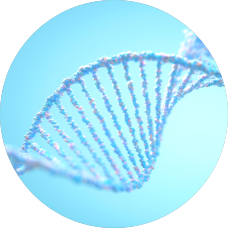Genetic ALS:
new innovations,
deeper understanding
Home / Developments in genetic ALS research
Accelerating the pace of genetic discovery
The race to understand “genetic ALS” began before anyone even called it by that name—in 1993—when mutations in the SOD1 gene were first established as a genetic component of the disease.1 The pace of discovery has accelerated since then.
To date, mutations in more than 25 genes have been associated with ALS.2 And while there is no telling just how many ALS-associated mutations remain to be discovered,3 advances in the way researchers make those discoveries have accelerated progress in recent years.2
Since 2014, new sequencing techniques including genome-wide association studies, whole genome studies, and exome sequencing have led to the discovery of ALS-associated mutations in 7 genes: MATR3, CHCHD10, TBK1, TUBA4A, NEK1, C21orf2, and CCNF.2 It was in 2017 that the largest-ever analysis of whole-exome sequencing data in China revealed that mutations in the NEK1 gene were associated with ALS there, a finding that came soon after the discovery of NEK1 as a risk gene in Europe.4
Since 2016, new sequencing techniques have led to the discovery of ALS-associated mutations in three additional genes: NEK1, C21orf2, and CCNF.2
Researchers have also integrated additional techniques to sequencing to identify genetic causes of disease in patients with seemingly sporadic ALS (sALS) patients. In 2020, researchers employed identity-by-descent analysis to examine data from 83 familial ALS (fALS) patients and three sALS patients from Australia. Through their analysis, the researchers were able to identify a genetic link between sALS and fALS cases via shared ancestral haplotypes.6
As more novel strategies for researching and understanding genetic ALS are introduced—and more mutations are found to be linked to this rare disease across diverse populations—information sharing across borders comes to feel like a valuable component of genetic ALS research.
Global perspectives from genetic ALS experts
The push for innovation, understanding, and improved approaches to clinical care in genetic ALS is taking place on nearly every continent, and several key genetic ALS experts are helping to lead that charge.
Prof. Steve Vucic
Professor of Medicine at the University of Sydney Westmead Clinical School
Prof. Vucic, of the University of Sydney Westmead Clinical School, conducts research involving the widely held multi-step theory of ALS, in which it is posited that genetic mutations combine with other factors, such as epigenetic changes and environmental triggers, to bring about disease onset.7
In Prof. Vucic’s view, genetic testing of all patients with or at risk for ALS could help neurologists achieve a deeper understanding of the genetic components of the disease.
Prof. Matthew Kiernan
Bushell Chair of Neurology at the University of Sydney and Co-Director of Discovery and Translation at the Brain and Mind Centre
Prof. Kiernan has focused his research on the possible connections between genetic ALS mutations and cortical hyperexcitability.
Prof. Kiernan and his team have discovered that the presence of a genetic ALS mutation can presage the development of cortical hyperexcitability, which, in turn, is often followed months later by the onset of ALS symptoms.8,9
His research on cortical hyperexcitability as a potential biomarker for genetic ALS dovetails with a 2019 study from the United States examining levels of phosphorylated neurofilament heavy protein (pNfH) in the blood and cerebrospinal fluid of individuals with, or at risk for, ALS. Among those with repeat expansion mutations in SOD1, FUS, and C9orf72, elevated pNfH levels preceded disease onset by anywhere from 6 months to 3.5 years.10
Researchers believe that confirming biomarkers such as these may hold promise for the early diagnosis of genetic ALS—a disease which is often diagnosed far too late.11
Prof. Orla Hardiman
Professor of Neurology/Head of Academic Clinical Medicine & Trinity Inst. of Neurosciences
In Ireland, Prof. Orla Hardiman and her team at Trinity College Dublin have focused on the heritability of genetic ALS.
By studying Irish patients and their children, Prof. Hardiman and her team made fascinating discoveries about the frequency with which genetic ALS develops among at-risk individuals in their country—including what appeared to be an increased likelihood of heritability among mothers and daughters compared with other familial pairings.12
Prof. Steve Vucic
Prof. Steve Vucic
Professor of Medicine at the University of Sydney Westmead Clinical School
Prof. Vucic, of the University of Sydney Westmead Clinical School, conducts research involving the widely held multi-step theory of ALS, in which it is posited that genetic mutations combine with other factors, such as epigenetic changes and environmental triggers, to bring about disease onset.7
In Prof. Vucic’s view, genetic testing of all patients with or at risk for ALS could help neurologists achieve a deeper understanding of the genetic components of the disease.
Prof. Matthew Kiernan
Prof. Matthew Kiernan
Bushell Chair of Neurology at the University of Sydney and Co-Director of Discovery and Translation at the Brain and Mind Centre
Prof. Kiernan has focused his research on the possible connections between genetic ALS mutations and cortical hyperexcitability.
Prof. Kiernan and his team have discovered that the presence of a genetic ALS mutation can presage the development of cortical hyperexcitability, which, in turn, is often followed months later by the onset of ALS symptoms.8,9
His research on cortical hyperexcitability as a potential biomarker for genetic ALS dovetails with a 2019 study from the United States examining levels of phosphorylated neurofilament heavy protein (pNfH) in the blood and cerebrospinal fluid of individuals with, or at risk for, ALS. Among those with repeat expansion mutations in SOD1, FUS, and C9orf72, elevated pNfH levels preceded disease onset by anywhere from 6 months to 3.5 years.10
Researchers believe that confirming biomarkers such as these may hold promise for the early diagnosis of genetic ALS—a disease which is often diagnosed far too late.11
Prof. Orla Hardiman
Prof. Orla Hardiman
Professor of Neurology/Head of Academic Clinical Medicine & Trinity Inst. of Neurosciences
In Ireland, Prof. Orla Hardiman and her team at Trinity College Dublin have focused on the heritability of genetic ALS.
By studying Irish patients and their children, Prof. Hardiman and her team made fascinating discoveries about the frequency with which genetic ALS develops among at-risk individuals in their country—including what appeared to be an increased likelihood of heritability among mothers and daughters compared with other familial pairings.12
Examining the role of genetic testing in ALS
The ultimate goal of genetic ALS research is, of course, to learn more about the disease and improve care for patients and their families. There are multiple clinical trials currently underway for which patients with specific genetic mutations may be eligible.13
Genetic testing is often necessary to determine eligibility for these trials, and there is a movement among some ALS experts to have genetic testing added to the standard diagnostic criteria for the disease.14-16
Other recent studies have demonstrated the potential usefulness of genetic testing as well. A 2021 study from England, conducted on behalf of Project MinE, identified 22 clinically reportable pathogenic or likely pathogenic mutations across 21 patients—more than half of whom had apparently sporadic disease. Fifteen of these patients carried SOD1 or C9orf72 mutations, making them eligible for ongoing clinical trials. Considering that another 21 patients were found to have a mutation of unknown significance—and that more ALS-associated mutations may remain to be uncovered—the trial provided further rationale for considering genetic testing for all patients with ALS.3,13
Genetic testing algorithm
Prof. Philippe Corcia of the Centre LSA in Tours, France—and one of the world’s leading proponents of genetic testing as a consideration for all patients living with ALS—has even gone so far as to propose a genetic testing algorithm to assist neurologists as demand increases.20
Organizations mapping a way forward in genetic ALS
Project MinE
Project MinE is a partnership between the ALS Foundation of The Netherlands, the Netherlands ALS Centre, and a group of dedicated ALS experts and patients. Their goal is to map the DNA profiles of at least 15,000 patients with ALS to better understand the genetic components of the disease.17
CAPTURE
Project MinE shares a mission with CAPTURE (Comprehensive Analysis Platform To Understand, Remedy, and Eliminate) ALS, a research initiative currently in development by ALS Canada designed to analyze the whole genome sequences, proteins, gene expression, epigenetics, and biochemical metabolites of patients living with ALS in an effort to improve clinical care.18
NEALS
NEALS (Northeast Amyotrophic Lateral Sclerosis Consortium) is a consortium of research centers with the mission of rapidly translating scientific advances into clinical research and new approaches to treatment for patients with ALS and other motor neuron diseases.19
References: 1. Boylan K. Familial amyotrophic lateral sclerosis. Neurol Clin. 2015;33(4):807-830. 2. Chia R, Chiò A, Traynor BJ. Novel genes associated with amyotrophic lateral sclerosis: diagnostic and clinical implications. Lancet Neurol. 2018;17(1):1-17. 3. Nguyen HP, Van Broeckhoven C, van der Zee J. ALS genes in the genomic era and their implications for FTD. Trends Genet. 2018;34(6):404-423. 4. Gratten J, Zhao Q, Benyamin B, et al. Whole-exome sequencing in amyotrophic lateral sclerosis suggests NEK1 is a risk gene in Chinese. Genome Med. 2017;9(1):97. doi:10.1186/s13073-017-0487-0. 5. Asultan AA, Waller R, Heath PR, Kirby J. The genetics of amyotrophic lateral sclerosis: current insights. Degener Neurol Neuromuscul Dis. 2016;6:49-64. 6. Henden L, Twine NA, Szul P, et al. Identity by descent analysis identifies founder events and links SOD1 familial and sporadic ALS cases. NPJ Genom Med. 2020;5:32. doi:10.1038/s41525-020-00139-8 7. Chiò A, Mazzini L, D’Alfonso S, et al. The multistep hypothesis of ALS revisited: the role of genetic mutations. Neurology. 2018;91(7):e635-e642. doi:10.1212/WNL.0000000000005996 8. Vucic S, Nicholson GA, Kiernan MC. Cortical hyperexcitability may precede the onset of familial amyotrophic lateral sclerosis. Brain. 2008;131(pt 6):1540-1550. 9. van den Bos MAJ, Geevasinga N, Higashihara M, Menon P, Vucic S. Pathophysiology and diagnosis of ALS: insights from advances in neurophysiological techniques. Int J Mol Sci. 2019;20(11):2818. doi:10.3390/ijms20112818. 10. Benatar M, Wuu J, Lombardi V, et al. Neurofilaments in pre-symptomatic ALS and the impact of genotype. Amyotroph Lateral Scler Frontotemporal Degener. 2019;20(7-8):538-548. 11. Mitropoulos K, Katsila T, Patrinos GP, Pampalakis G. Multi-omics for biomarker discovery and target validation in biofluids for amyotrophic lateral sclerosis diagnosis. OMICS. 2018;22(1):52-64. 12. Ryan M, Heverin M, McLaughlin RL, Hardiman O. Lifetime risk and heritability of amyotrophic lateral sclerosis. JAMA Neurol. 2019;76(11):1367-1374. doi:10.1001/jamaneurol. 2019.2044 13. Shepheard SR, Parker MD, Cooper-Knock J, et al; on behalf of Project MINE Consortium; Project MinE. Value of systematic genetic screening of patients with amyotrophic lateral sclerosis. J Neurol Neurosurg Psychiatry. 2021;jnnp-2020-325014. doi:10.1136/jnnp-2020-325014. 14. Chiò A, Calvo A, Moglia C, et al. Clinical utility of whole-genome sequencing in an ALS cohort. Presented at: American Academy of Neurology Virtual Annual Meeting; April 17-22, 2021. 15. Salmon K, Glass J, Genge A, et al. Amyotrophic lateral sclerosis (ALS) genetic testing: current landscape and potential needs. Presented at: American Academy of Neurology Virtual Annual Meeting; April 17-22, 2021. 16. Rich K, Roggenbuck J, Palettas M, et al. The ALS genetic access program: paving the way for genetic testing, counseling and therapy for ALS. Presented at: American Academy of Neurology Virtual Annual Meeting; April 17-22, 2021. 17. Project MinE. Accessed October 28, 2021. https://www.projectmine.com. 18. ALS Society of Canada. Accessed October 28, 2021. https://als.ca/research/als-canada-research-program/other-initiatives/. 19. Northeast Amyotrophic Lateral Sclerosis Consortium. Accessed October 28, 2021. https://www.neals.org/about-us/our-mission/ . 20. Corcia P, Lumbroso S, Cazaneuve C, Mouzat K, Camu W, Vourc'h P; on behalf of FILSLAN network. Pre-symptomatic diagnosis in ALS. Rev Neurol (Paris). 2020;176(3):166-169. doi:10.1016/j.neurol.2019.07.027
1. Boylan K. Familial amyotrophic lateral sclerosis. Neurol Clin. 2015;33(4):807-830. 2. Chia R, Chiò A, Traynor BJ. Novel genes associated with amyotrophic lateral sclerosis: diagnostic and clinical implications. Lancet Neurol. 2018;17(1):1-17. 3. Nguyen HP, Van Broeckhoven C, van der Zee J. ALS genes in the genomic era and their implications for FTD. Trends Genet. 2018;34(6):404-423. 4. Gratten J, Zhao Q, Benyamin B, et al. Whole-exome sequencing in amyotrophic lateral sclerosis suggests NEK1 is a risk gene in Chinese. Genome Med. 2017;9(1):97. doi:10.1186/s13073-017-0487-0. 5. Asultan AA, Waller R, Heath PR, Kirby J. The genetics of amyotrophic lateral sclerosis: current insights. Degener Neurol Neuromuscul Dis. 2016;6:49-64. 6. Henden L, Twine NA, Szul P, et al. Identity by descent analysis identifies founder events and links SOD1 familial and sporadic ALS cases. NPJ Genom Med. 2020;5:32. doi:10.1038/s41525-020-00139-8 7. Chiò A, Mazzini L, D’Alfonso S, et al. The multistep hypothesis of ALS revisited: the role of genetic mutations. Neurology. 2018;91(7):e635-e642. doi:10.1212/WNL.0000000000005996 8. Vucic S, Nicholson GA, Kiernan MC. Cortical hyperexcitability may precede the onset of familial amyotrophic lateral sclerosis. Brain. 2008;131(pt 6):1540-1550. 9. van den Bos MAJ, Geevasinga N, Higashihara M, Menon P, Vucic S. Pathophysiology and diagnosis of ALS: insights from advances in neurophysiological techniques. Int J Mol Sci. 2019;20(11):2818. doi:10.3390/ijms20112818. 10. Benatar M, Wuu J, Lombardi V, et al. Neurofilaments in pre-symptomatic ALS and the impact of genotype. Amyotroph Lateral Scler Frontotemporal Degener. 2019;20(7-8):538-548. 11. Mitropoulos K, Katsila T, Patrinos GP, Pampalakis G. Multi-omics for biomarker discovery and target validation in biofluids for amyotrophic lateral sclerosis diagnosis. OMICS. 2018;22(1):52-64. 12. Ryan M, Heverin M, McLaughlin RL, Hardiman O. Lifetime risk and heritability of amyotrophic lateral sclerosis. JAMA Neurol. 2019;76(11):1367-1374. doi:10.1001/jamaneurol. 2019.2044 13. Shepheard SR, Parker MD, Cooper-Knock J, et al; on behalf of Project MINE Consortium; Project MinE. Value of systematic genetic screening of patients with amyotrophic lateral sclerosis. J Neurol Neurosurg Psychiatry. 2021;jnnp-2020-325014. doi:10.1136/jnnp-2020-325014. 14. Chiò A, Calvo A, Moglia C, et al. Clinical utility of whole-genome sequencing in an ALS cohort. Presented at: American Academy of Neurology Virtual Annual Meeting; April 17-22, 2021. 15. Salmon K, Glass J, Genge A, et al. Amyotrophic lateral sclerosis (ALS) genetic testing: current landscape and potential needs. Presented at: American Academy of Neurology Virtual Annual Meeting; April 17-22, 2021. 16. Rich K, Roggenbuck J, Palettas M, et al. The ALS genetic access program: paving the way for genetic testing, counseling and therapy for ALS. Presented at: American Academy of Neurology Virtual Annual Meeting; April 17-22, 2021. 17. Project MinE. Accessed October 28, 2021. https://www.projectmine.com. 18. ALS Society of Canada. Accessed October 28, 2021. https://als.ca/research/als-canada-research-program/other-initiatives/. 19. Northeast Amyotrophic Lateral Sclerosis Consortium. Accessed October 28, 2021. https://www.neals.org/about-us/our-mission/ . 20. Corcia P, Lumbroso S, Cazaneuve C, Mouzat K, Camu W, Vourc'h P; on behalf of FILSLAN network. Pre-symptomatic diagnosis in ALS. Rev Neurol (Paris). 2020;176(3):166-169. doi:10.1016/j.neurol.2019.07.027







